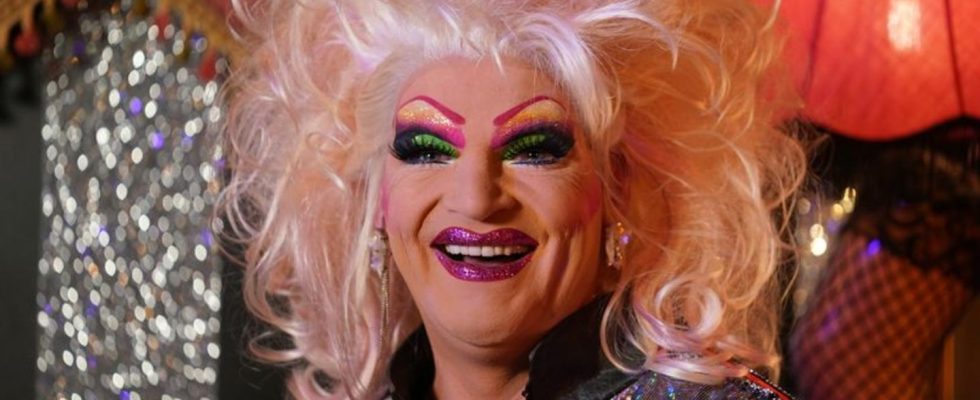Formerly underground, today entertainment for millions: drag queens are well received. Now the RTL show “Viva la Diva – Who is the Queen?” return.
At the latest when Olivia Jones ended up in the final of the jungle camp ten years ago and a year later Conchita Wurst won the Eurovision Song Contest, it became clear that drag queens in this country also met with millions of sympathy.
Since then, their art, which used to be celebrated primarily in the gay subculture, has become more and more accessible to the masses. On the day against homophobia, biphobia, interphobia and transphobia (May 17), ARD recently celebrated a ratings hit with the comedy “Meine Freund Volker”. In it, “Tatort” star Axel Milberg mimicked the character Volker, aka scene star Vivian Bernaise.
RTL is now – after last year’s success – the celebrity guessing show “Viva la Diva – Who is the Queen?” away. In the show, in which Olivia Jones and Jorge González sit on the advice team and the expert jury includes drag queens Danny Ma Fanny, Laila Licious, Bambi Mercury, Catherine Leclery and Pam Pengco, celebrities dress up as ladies.
Who is on the advice team?
RTL emphasizes who it is this time will remain a secret until it is broadcast. Starting points could be hidden in the name, costume, color or music selection.
The streaming service Paramount+ has meanwhile announced a German branch of the internationally successful reality TV show “RuPaul’s Drag Race”, which is scheduled to start later this year.
“We’re born naked, and the rest is drag” (We’re born naked, and the rest is drag) – this sentence comes from world star Ru Paul. The 62-year-old probably wanted to use it to describe the cultural conditionality of gender appearances.
History of drag queens
“Drag Queens” are people who usually have a male identity, are often gay/queer, but wear clothes that are intended for the female gender according to heterosexual norms. The significantly less popular counterpart to drag queens are “drag kings” (often native to lesbian culture).
All this is by no means super new, but earlier terms such as travesty and travesty art sound old-fashioned today. In Germany, the duo Mary & Gordy was already known in the 1980s, later Lilo Wanders became a TV celebrity. Georgette Dee and many other quick-change artists are well known in the cabaret scene.
Internationally, drag queens are an integral part of show and film anyway, think of Divine (1945-1988), Dame Edna (actor Barry Humphries, who recently died at 89) and of course RuPaul.
sparked discussions
Just recently, however, there was a heated debate about drag queens – because of a planned reading for children aged four and over in a district library in Munich. Bavaria’s Deputy Prime Minister Hubert Aiwanger from the Free Voters claimed that this was “a threat to children’s welfare and a case for the youth welfare office, not cosmopolitanism like the Greens play down”.
Apparently, the fundamentalist discourse is spilling over from America to Germany that drag queens are a danger to children and young people. In the United States, the Republican-dominated state of Tennessee recently banned drag shows in public spaces anywhere in the presence of persons under the age of 18.
The law since April has defined such performances as “topless dancers, go-go dancers, exotic dancers, strippers, male or female impersonators who provide entertainment that appeals to a lustful interest.” States such as Arizona, Idaho, Kansas, Kentucky, Oklahoma, South Carolina and Texas are planning similar plans.
Drag queens in society
Drag queen culture is traditionally associated with frivolous jokes, teased wigs, sequins, glamorous costumes, lots of make-up and playback and imitation of idols such as Cher, Madonna, Donna Summer, Lady Gaga or Marlene Dietrich and Judy Garland.
Some even occasionally find drag queens to be misogynistic because they often portray femininity with bitchyness and completely exaggerated behavior.
Drag queens themselves often emphasize their (sociological) political intentions. They also differentiate themselves from transvestites who dress up for fetish reasons.
It gets very complicated for some when it comes to speaking dignified about the actually completely different topic of trans identity – i.e. when people don’t identify with the gender that was assigned to them at birth and therefore dress differently than might be expected.
Identity, gender-specific visual codes, the question of socially constructed gender in general – today all this often appears as mined terrain.
It is all the more astonishing that a TV show like “Viva la Diva” was one of the big TV surprises of the past year. In autumn, RTL received a German television award for the show. The private broadcaster is now broadcasting two new episodes on June 2nd and 9th.

